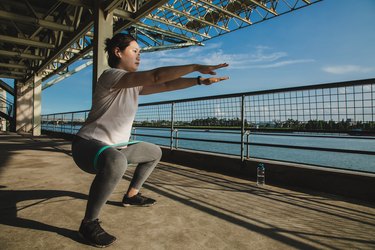
Perhaps you're changing your diet or fitness habits to build strength or lose weight. But quickly dropping pounds just to get smaller thighs can be dangerous and unattainable. Instead, make lifestyle changes that help you feel your best, like adding thigh-strengthening exercises to your routine.
Tip
It's not possible to only lose weight in a particular body part, like your thighs. And losing weight too quickly comes with health risks. Rather than trying to slim your thighs specifically, focus on creating a sustainable diet and exercise routine that supports your overall wellness.
Video of the Day
1. Set Realistic Goals
If you intend to lose weight, make sure you set realistic goals to help you do it safely and sustainably. That means dropping about 1 to 2 pounds per week through lifestyle changes like improved diet and exercise, according to the Centers for Disease Control and Prevention (CDC). Any more than that may deprive you of nutrients and make long-term weight loss more difficult, per the Mayo Clinic.
Video of the Day
While lifestyle changes can help you lose weight all over your body, they won't specifically target fat on your thighs (or any other single body part, for that matter), per an August 2013 study in The Journal of Strength and Conditioning Research. In other words, spot reduction isn't possible. Where and how fast you lose weight is subject to your genetics and unique body, according to the CDC.
And if your weight-loss goal is to get a thigh gap, remember that this often-unattainable trend reinforces the distorted "thin ideal," which claims that skinner is better and weight loss is necessary. In reality, you can be healthy at any size — no matter what your thighs look like — so instead, focus on a routine that helps you feel good mentally and physically.
2. Create a Calorie Deficit
If weight loss is your goal, eating fewer calories can help you shed pounds. The Mayo Clinic recommends a daily deficit of 500 to 1,000 calories for that gradual weight-loss rate of 1 to 2 pounds per week, respectively.
Your exact calorie goal depends on several traits, like how active you are, your age and sex. Estimate your calorie needs with the help of this Dietary Guidelines for Americans chart that breaks it down by those factors. From there, subtract your calorie deficit to get your daily calorie goal for weight loss.
Just make sure that your daily calorie intake doesn't fall below 1,200 per day if you're assigned female at birth or 1,500 per day if you're assigned male at birth, unless you're under the supervision of a health professional, per Harvard Health Publishing.
3. Eat a Nutritious Diet
While, technically, any calorie deficit can help you lose weight, it's best to prioritize healthy eating so you don't deprive yourself of nutrients. The CDC recommends including the following types of foods in a well-balanced diet.
1. Lean Protein
Protein is an important source of long-term energy and helps build and repair tissue, according to Harvard Health Publishing. The 2020-2025 Dietary Guidelines for Americans recommends adults eat 5 to 7 ounce equivalents of protein per day. Ounce equivalents account for varying amounts of protein in different foods, per the U.S. Department of Agriculture: For instance, the protein in one egg is equivalent to that in an ounce of meat.
Including protein in a weight-loss diet helps you feel full and helps you hang on to lean muscle mass as you're losing fat, which supports a healthy metabolism.
Protein-rich foods include:
- Lean meats like chicken and turkey breast
- Fish like salmon and tuna
- Nuts and seeds
- Soy products like tofu and tempeh
- Legumes like beans and lentils
- Dairy products like yogurt and cottage cheese
- Eggs
2. Eat Fibrous Foods
You'll also want to eat plenty of fiber, a type of carbohydrate that provides lasting energy and aids digestion, according to the National Institute on Aging (NIA).
Upping your fiber intake has been linked to weight loss: A study of 240 people found that simply consuming 30 grams of fiber daily was an effective alternative to more complicated weight-loss diets, according to February 2015 research in the Annals of Internal Medicine.
Fruits and vegetables are one solid source of fiber, according to the CDC. As a bonus, they're also loaded with water to help you stay hydrated, per the Cleveland Clinic.
According to the NIA, whole grains are another important source of the nutrient, including:
- Whole-wheat breads, pastas and cereals
- Oatmeal
- Quinoa
- Amaranth
3. Avoid or Limit Processed Foods
Getting slim thighs isn't all about deprivation, but you'll want to limit your intake of processed foods. These foods typically contain lots of unhealthy fats and carbohydrates, according to the NIA. They also tend to be calorie-dense, which can make it difficult to create a calorie deficit if that's one of your goals.
Per the NIA, consider skipping processed foods such as:
- Fast food
- Packaged baked goods like cakes and cookies
- Chips and crackers
- Fatty meats like bacon and sausage
- Margarine
- Soft drinks
- Candy
Plan ahead so you don't hit the vending machine or the drive-thru. Keep an ounce of almonds in your bag to eat instead of a bag of chips, for example, and pack healthy meals you can eat on-the-go, like a breakfast smoothie made from Greek yogurt, fruits, veggies or a turkey and vegetable wrap in a whole-wheat tortilla.
4. Exercise
Whether or not slimming down your thighs is your goal, regular exercise can help build strength, improve mobility and support mental health, according to the NIA.
And though exercising a specific body part can help you build strength in that area, it won't lead to targeted weight loss, per The Journal of Strength and Conditioning Research. So rather than focusing your workouts on getting smaller thighs alone, build a well-rounded fitness routine to develop strength and mobility throughout your body.
Here are some things to keep in mind as you develop your exercise program.
Cardiovascular Exercise
Cardio is a crucial part of any fitness routine. The Physical Activity Guidelines for Americans recommends adults get 2.5 to 5 hours of moderate-intensity aerobic activity every week, which can help you manage weight, improve sleep and help prevent conditions like high blood pressure or heart disease.
If you want to target your thighs specifically, pick an activity that uses those muscles, such as:
- Walking
- Hiking
- Running
- Biking
- Rowing
- Step aerobics
- Dance classes like Zumba
- Skiing
- Skating
- Roller-blading
- High-intensity interval training
Strength Training
Strength training is equally important when it comes to reaping the mental and physical benefits of exercise. The Physical Activity Guidelines for Americans suggests doing strength-building activities at least twice a week, ideally on nonconsecutive days so that your muscles have a chance to rest and repair themselves, per the Cleveland Clinic.
Strength training your thighs specifically can help you build muscle and tone in your upper legs, according to the Cleveland Clinic. That added muscle can support a healthy metabolism and, as a result, help with weight loss.
Common types of strength training include:
- Weight training like weightlifting and circuit training
- Bodyweight exercises like push-ups or squats
- TRX
Avoid Overtraining
If you're trying to strengthen your thighs, you might feel tempted to target them with exercise every day to speed up your results.
But resist the urge: Overtraining can actually damage your muscles and put you at risk for a training injury, according to the Cleveland Clinic. That's why it's important to take rest days and alternate high-intensity workouts with gentler forms of exercise, like walking, stretching or yoga.
Best Thigh-Slimming Exercises
Build strength and mobility in your legs with these exercises to tone your thighs:
- Squats, including split-leg and single-leg squats
- Lunges, including side and curtsy lunges
- Deadlifts
- Kettlebell swings
- Glute bridges
- Hamstring curls
- Centers for Disease Control and Prevention: "Losing Weight"
- Mayo Clinic: "Why do doctors recommend a slow rate of weight loss? What's wrong with fast weight loss?"
- Centers for Disease Control and Prevention: "Behavior, environment, and genetic factors all have a role in causing people to be overweight and obese"
- The Journal of Strength and Conditioning Research: "Regional fat changes induced by localized muscle endurance resistance training"
- Mayo Clinic: "Counting calories: Get back to weight-loss basics"
- Harvard Health Publishing: "Calorie counting made easy"
- Centers for Disease Control and Prevention: "Healthy Eating for a Healthy Weight"
- Harvard Health Publishing: "The power of protein"
- National Institute on Aging: "Important Nutrients to Know: Proteins, Carbohydrates, and Fats"
- Annals of Internal Medicine: "Single-Component Versus Multicomponent Dietary Goals for the Metabolic Syndrome"
- Cleveland Clinic: "Dehydrated? These 7 Foods Will Satisfy Your Thirst and Hunger"
- Centers for Disease Control and Prevention: "Can eating fruits and vegetables help people to manage their weight?"
- U.S. Department of Health and Human Services and U.S. Department of Agriculture: "2020-2025 Dietary Guidelines for Americans"
- National Institute on Aging: "Real-Life Benefits of Exercise and Physical Activity"
- U.S. Department of Health and Human Services: "Physical Activity Guidelines for Americans, 2nd Edition"
- Cleveland Clinic: "Want to Lose Weight? Build Muscle"
- Cleveland Clinic: "Strenuous Workouts: Try These 6 Best Recovery Tips"
- Cleveland Clinic: "Signs That Exercise Is Actually Hurting Your Health"
- U.S. Department of Agriculture: "What counts as an ounce in the Protein Foods Group?"
- U.S. Department of Health and Human Services and U.S. Department of Agriculture: "Appendix 2. Estimated Calorie Needs per Day, by Age, Sex, and Physical Activity Level"


